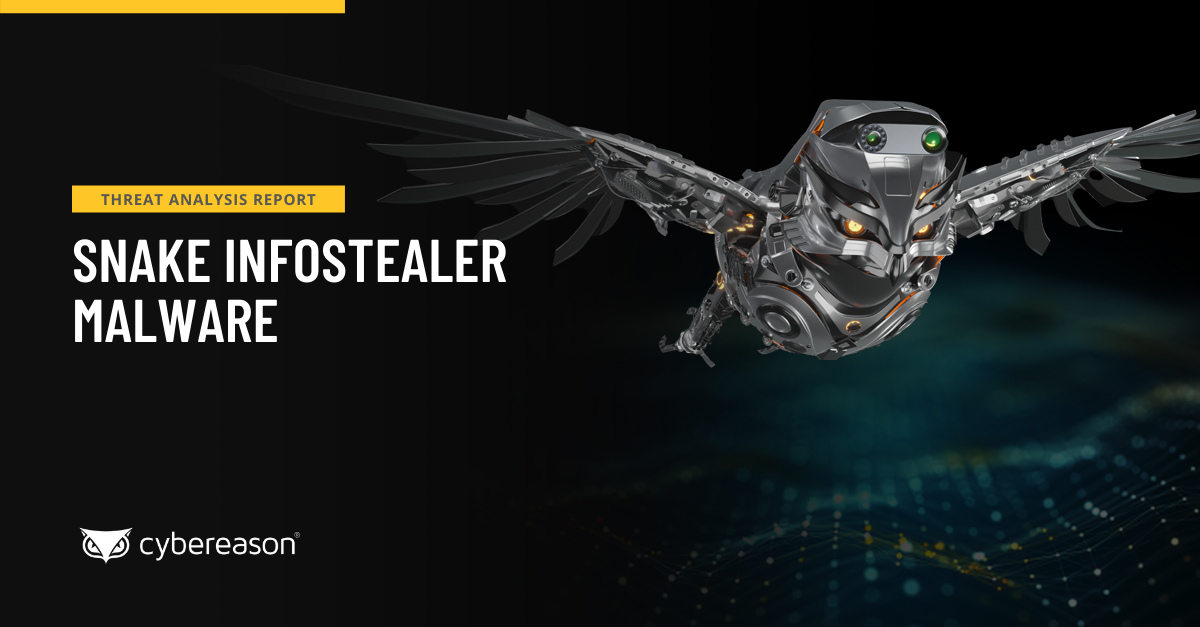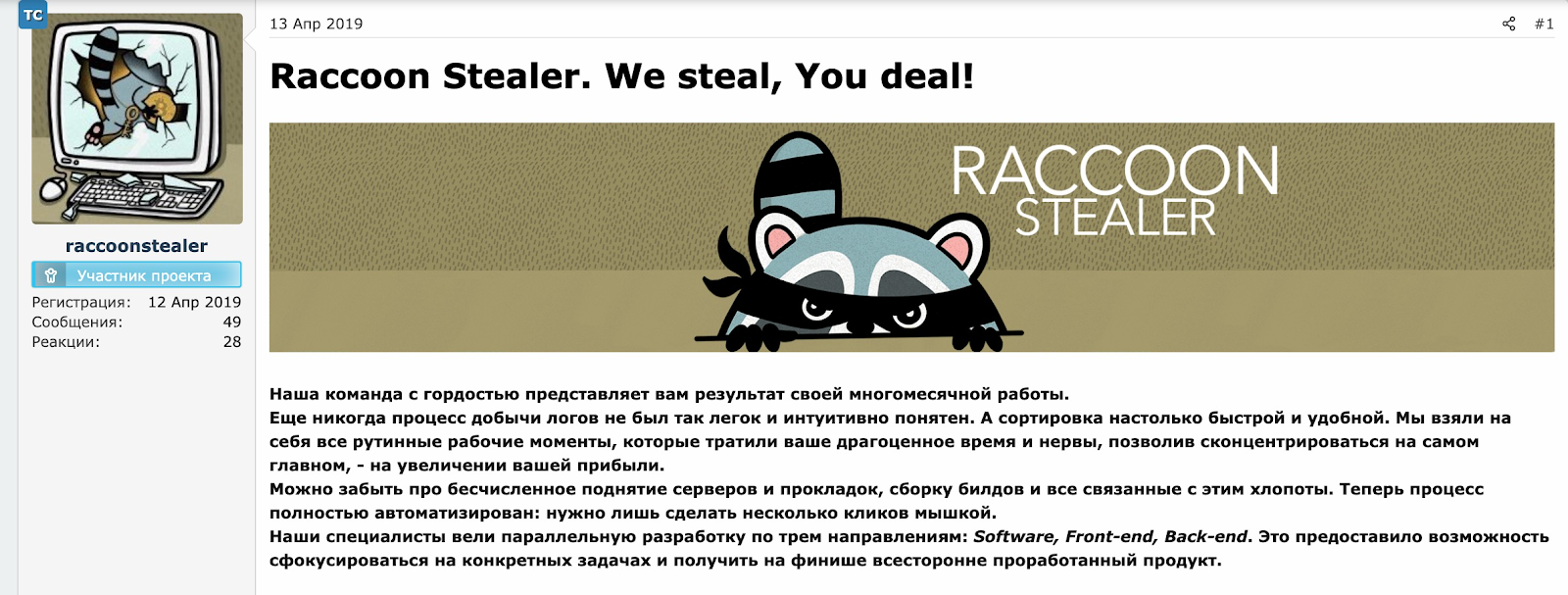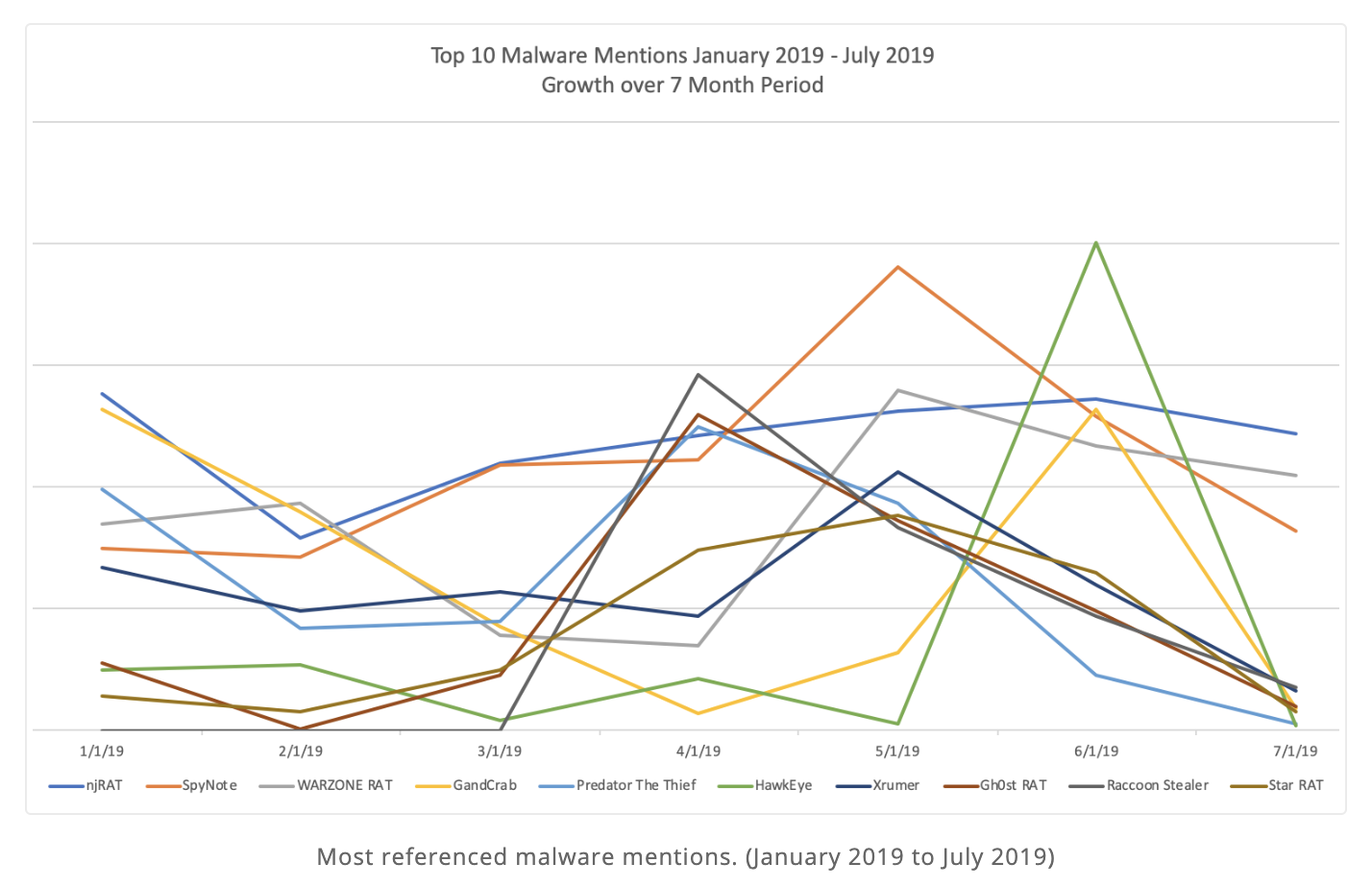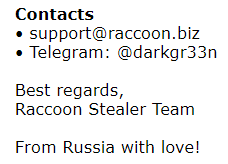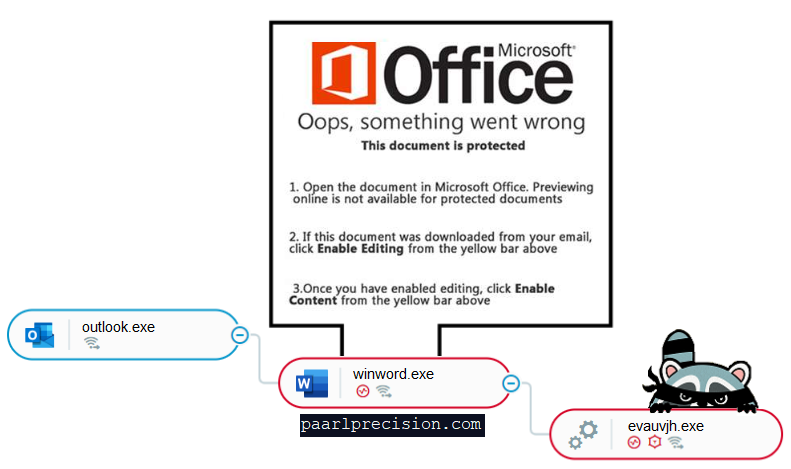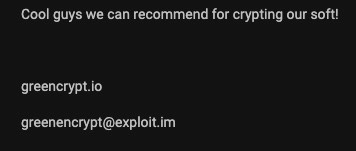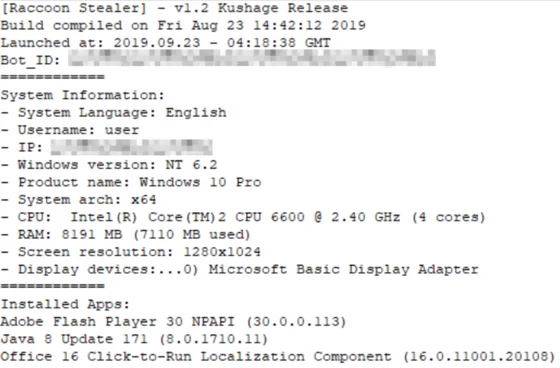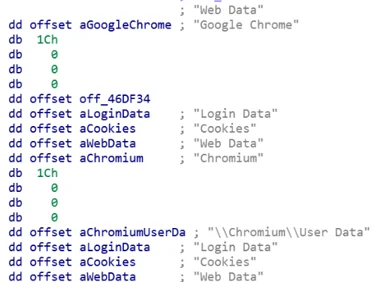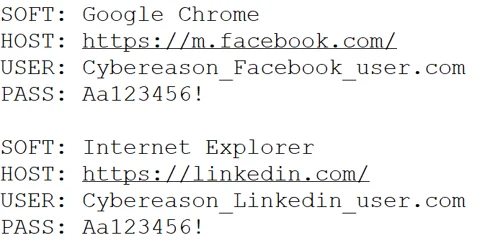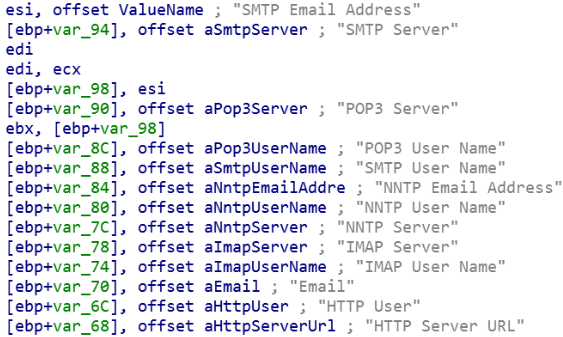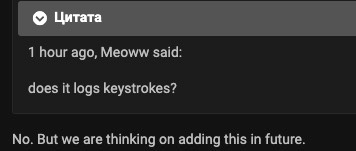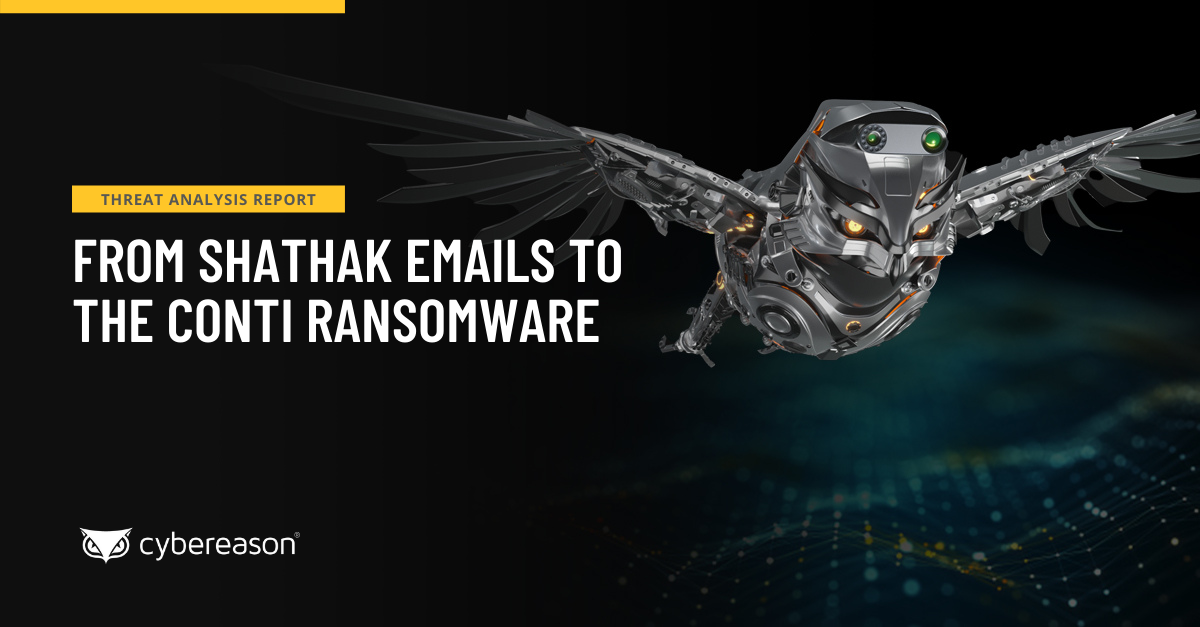Research by: Assaf Dahan & Lior Rochberger
Introduction
Since April 2019, the Cybereason Nocturnus team has investigated multiple infections of the Raccoon stealer in the wild across organizations and individuals. In this research, we focus on two key aspects:
- A Glimpse Into the Underground: A survey of Raccoon’s origin, team members, business model, and marketing efforts, as well as Raccoon’s reception by the underground cybercrime community and the existing feuds between Raccoon’s team and their direct competitors.
- A Technical Breakdown: A comprehensive technical overview of Raccoon’s current capabilities and delivery methods, with a look into their future plans for the malware.
The top 10 malware mentions over seven months in 2019 from Recorded Future.
The Raccoon stealer is one of the 2019 top 10 most-mentioned malware in the underground economy and is widely known to have infected hundreds of thousands of devices around the world, despite it not being overly sophisticated or innovative. This strain of malware first emerged as recently as 2019, and has already established a strong following among cybercriminals. Its popularity, even with a limited feature set, signals the continuation of a growing trend of the commoditization of malware as they follow a MaaS (Malware-as-a-Service) model and evolve their efforts.
Build an iterative defense that addresses threats like these. Read our white paper on how to use MITRE ATT&CK to create a closed-loop security process.
Key Points
- The Raccoon Infostealer: The Cybereason Nocturnus team has been investigating multiple incidents involving the Raccoon infostealer since April 2019, and is now able to give a thorough analysis of the technical aspects of the malware alongside a look into the likely Russian team behind it.
- Steals a Wide Range of Data: Raccoon lacks sophistication, but leverages several potential delivery methods and is able to steal a large swath of important data, including credit card information, cryptocurrency wallets, browser data, and email credentials.
- Is Quickly Gaining Traction: Despite being released earlier this year, the Raccoon stealer is exploding in popularity in the underground community to become one of the top 10 most-referenced malware on the market in 2019, infecting hundreds of thousands of endpoints globally across organizations and individuals in North America, Europe, and Asia.
- Enables Any Individual to Easily Commit Cybercrime: Raccoon follows a malware-as-a-service model, allowing individuals a quick-and-easy way to make money stealing sensitive data without a huge personal investment or technical know-how.
- Has a Strong Following Underground: The team behind Raccoon is lauded in the underground community for their level of service, support, and user experience, but has faced several bouts of public feuds and internal disputes.
TABLE OF CONTENTS
Raccoon, also known as “Mohazo” or “Racealer”, is at its core a simple information stealer often seen delivered by the Fallout and RIG Exploit Kits. It is used to steal data like credit card information, cryptocurrency wallets, browser-related data, and mail clients. Although it is not an advanced malware, it is estimated to have infected hundreds of thousands of devices around the world and is in the top 10 mentioned in the underground communities for 2019.
Raccoon is written in C++ and works on both 32-bit and 64-bit operating systems. Though it was originally classified as a password stealer by many AV companies, we and others in the community see it leverage broader capabilities and categorize it as an information stealer.
Raccoon searches system files for a range of confidential data which it saves and sends to its operator. It is able to collect the following data:
- Credit Card Data
- Cryptocurrency Wallets
- Passwords
- Emails
- Data from All Popular Browsers Including Credit Card Info, URLs, Usernames, Passwords
- Cookies
- System Information
Threat Actor Overview
The Raccoon stealer is developed by a team that appears to originate in Russia and be Russian-speaking. The team initially promoted the stealer in exclusively Russian-speaking hacking forums, but now actively promotes it in English-speeaking communities as well. It is aggressively marketed in the cybercrime underground and has been since April 2019.
Raccoon stealer marketed in a Russian underground forum.
Raccoon is sold as a MaaS with features like an easy-to-use automated backend panel, bulletproof hosting, and 24/7 customer support in both Russian and English. As of this writing, it costs $200 per month to use.
How to contact the Raccoon Team.
Much like any other software-as-a-service, the Raccoon stealer appears to be in active development. The development team seems to be quick, responsive, and dedicated, using short development cycles to release updates, bug fixes, and new features within days. They are also highly active in underground communities under the username raccoonstealer. They post daily and reply to community questions and comments within hours in underground forums and on Telegram.
Who is behind the Raccoon Stealer?
While the identity of the team behind Raccoon remains unknown, some members in the underground community attribute the project to another well-known member, glad0ff. Alexuiop1337, the author of predator stealer and one of the strongest critics of Raccoon, was one of the first to make this allegation. Of course, the accusations made by direct competitors should be taken with a grain of salt. However, the leads Alexuiop1337 provided in his blog can potentially tie glad0ff to Raccoon.
An analysis of the Raccoon stealer’s hacked panel and leaked customer base could imply the admin of Raccoon is a user with the online handle glad0ff. The user glad0ff was created in the Raccoon stealers database in February of 2019, roughly two months before the team began aggressively marketing Raccoon to the underground community.
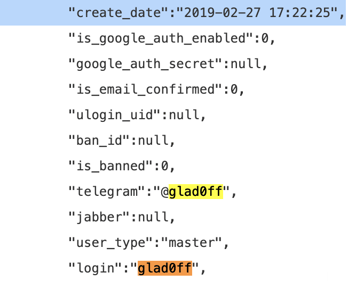
glad0ff user creation date in Raccoon’s database.
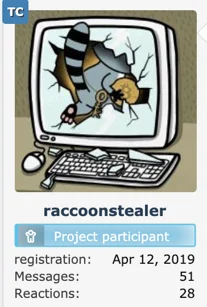
One of the first mentions of Raccoon in underground forums.
Who is glad0ff?
glad0ff is a long-time threat actor responsible for developing malware like the Decrux and Acrux cryptominers, the Mimosa RAT and the ProtonBot loader. glad0ff caters to less sophisticated cyber criminals looking for easy-to-use, end-to-end solutions. Similar to customers of Raccoon, customers from many of glad0ff’s previous projects praise the quality of service, dedication, and responsiveness when fixing issues. It was previously believed that glad0ff operated alone, however, there are indications that the Raccoon stealer involved other members, as we discuss later on.
It’s also interesting to note that glad0ff stopped posting in many underground forums in April of 2019, which aligns with the launch of the Raccoon stealer.
Last seen date for the glad0ff user.
Is Raccoon Tied to Malware from Other Threat Actors?
Other members in the underground community have questioned whether Raccoon is linked to other stealers like Vidar and Baldr, as they noticed great similarities between the aforementioned infostealers. Raccoon team members consistently deny any ties to other stealers.
“Do you have any relation to the Vidar team?” Reply: “No.”
Raccoon’s Reception in the Underground Community
It is interesting to note that many individuals choose to write reviews for Raccoon. As malware authors turn to MaaS, they follow many of the same paths as a legitimate SaaS business: marketing efforts, relying on positive reviews, responsive customer support, and regularly improving features in their product.
Positive Feedbacks and Endorsements
Generally, feedback around Raccoon in the underground community is positive. Many in the community praise and endorse Raccoon’s malware capabilities and the services the team provides. Some voices in the community even endorse it as a worthy replacement for the famous Azorult stealer. However, it is important to note that there are some dissenting opinions. Advanced members in the community find Raccoon to be simple and lacking in features when compared to other information stealers. With that said, many in the community believe that while the malware may lack in features, sophistication, or innovation, it largely makes up for it with consistency and an impressive level of service, support, and quality user experience.
Raccoon’s popularity combined with its limited feature set yet high adoption speaks to a growing trend of the commoditization of malware, as malware authors shoot to create platforms for crime instead of committing the crimes directly.
Example #1: Early Adopter Replaces Azorult
This early adopter of Raccoon claims he has been using it since the initial launch. After Azorult was shut down at the end of 2018, he tried almost every stealer on the market before settling on Raccoon.
“I am among the first clients of these guys, practically using their product since the initial launch. I have used many other stealers before, essentially i tried all there is in this market to offer. After the “death” of “azora” (Azorult malware), I searched for a long time for a decent replacement and finally, found it in Racoon!
Example #2: Praise for Excellent Service
This user leveraged a free trial of Raccoon, and deemed it an excellent product they were interested in switching to. They specifically reference one instance where there was a bug in the panel’s search engine that was fixed immediately on the fly.

“They let me try the stealer for a few days. In general, first impressions were good. The rate of successful infection is very good. Had an issue with the control panel’s search engine. Problem was solved immediately, on the fly ) There is no support for IE, and the download of all logs, but i have been told that these features will be added in the near future. Not bad at all. Thinking of getting it as soon as my current lease is over)”
Example #3: User Testimonial - A Worthy Replacement for Azorult
This user switched from Azorult to Raccoon because of how easy the control panel was to use. In addition, the user experiences a very high success rate and is a big supporter of the quality of service.
“I switched from azor (Azorult) to raccoon and got a great joy of how convenient the admin control panel is, there are no extra, unnecessary details such as in vidar (Vidar malware) but there are these small, little details that are helpful and mandatory for people who process a large amount of logs. If judging the build, that everything is alright, with azor i always had around 60%+ of successful infection rate and here i found a good crypter and have 90% of rate…[snipped] What surprised me is the support that treats you as a VIP class client, they will do whatever you demand and with expressing gratitude, etc. it is very nice and I have never seen experienced it anywhere else.”
Criticism of Raccoon by Members of the Underground Community
Since day one, some members of the underground community have criticized Raccoon, specifically targeting it's lack of capabilities, poor coding, and several security issues in the infrastructure and admin panel code.
Perhaps one of the most negative reviews comes from Alexuiop1337. Alexuiop1337 wrote a very detailed blog dissecting and criticizing the malware and its infrastructure. According to Alexuiop1337, Raccoon has vulnerabilities that let attackers DDoS their servers and dump sensitive data. In his review, Alexuiop1337 also tries to expose the identity of one of the developers behind Raccoon by claiming it is glad0ff/wankfbi, another member of the underground community
Other negative reviews voiced by customers or testers complain that Raccoon has:
- A low success rate for infection at about 45%.
- Some bugs that make it difficult to access logs and delete logs from the control panel.
- Some missing information or version compatibility issues in its stealing modules.
“- The stealer often doesn’t still software or its version, and for me it was important
The cookies from the stealer are often transferred incomplete,
I don't understand why it does it, but in the previous stealer there were no such problems ”
Public Disputes and Controversies with the Raccoon Team
Within the underground community, the Raccoon team is also facing some public disputes and controversies. These disputes offer an important glimpse into the inner workings of the team and give a broader sense of just how competitive the commodity malware market is.
In addition, these conflicts validate our hypothesis that Raccoon is not operated by a single user, but by a team. It gives insight into the types of relationships the team members have and how fragile and opportunistic those ties can be.
Internal Disputes Shed Light on the Raccoon Team Dynamics
The first public signs of tension between Raccoon team members began shortly after their launch in April. Following a leak of their customer database, the team released a statement claiming their servers were not hacked, but that the leak was caused by a disgruntled team member using the database as blackmail for more money. When the team member demands were not met, they released the database to embarrass the Raccoon team. Though the team explicitly states the blackmailer was not working directly with their competitors, they did accuse Alexuiop1337 and overdot of hyping the situation in order to capitalize on it.
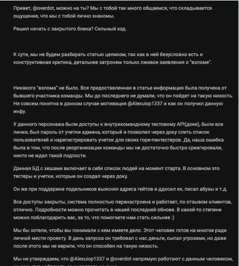
“The aforementioned user had access to the intra-team test API (dock), had all the links, had a password from the admin account, which allowed us to document the list of users and register accounts for their unfortunate pentesters. Yes, our mistake was that after the reorganization of the team, we did not react quickly enough, no one expected such meanness.”
“This person will do what it takes, for personal revenge against the project. On the launch day, he demanded money from us, threatened us, but even after that we couldn’t believe that he was capable of such baseness.”
“We do not claim that @Alexuiop1337 and @overdot work directly with this person, but an attempt to hype this situation on behalf (of the aforementioned person)”
Additionally, in June of 2019 raccoonstealer published an unusual post that revealed an internal feud with former team members. Allegedly, Participant 777 (777@raccoon.biz) stole $900 from the community balance and left the project.

"Attention!
We do not offer any services except the rental of our software! Participant 777 left the project, taking $900 from the shared common fund. There was scam attempt from the telegram account @enot_support.
In the “expe” (a Russian slang for the infamous “exploit[.]in” underground hacking community), they blacklisted the aforementioned account.
THE ONLY CONTACTS FOR CONTACTING US!
Jabber: support@raccoon.biz randomuser@ucia.icu green@raccoon.biz Telegram: @ darkgr33n“
These two incidents make it clear that Raccoon is developed by several individuals that work together, but are not necessarily a tight-knit team.
Raccoon Stealer Overview
How is Raccoon Delivered?
Raccoon is delivered in multiple ways, though we see Raccoon delivered most often through exploit kits, phishing attacks, and through bundled malware.
Delivery by Exploit Kit
Exploit kits automatically exploit vulnerabilities on a victim’s machine while they are browsing the web. In browsing the web, the user visits a malicious page that redirects to a landing page containing exploit code, often executed without the users consent or interaction.
In order to deliver Raccoon, the attackers leverage the Fallout exploit kit to spawn a PowerShell instance from Internet Explorer and subsequently download the main payload of the infostealer.
The Fallout exploit kit delivers Raccoon, as seen in the Cybereason platform.
Delivery by Phishing
Phishing is a social engineering attack where a user is tricked into executing malicious content. Most commonly, the user receives an email with an attached Office document. This document contains embedded malicious macro code that, when opened, executes.
In order to deliver Raccoon, the attackers use an email with an attached Word document. Upon opening the Word document and enabling macros, the macro code creates a connection to a malicious domain and downloads the main payload of the infostealer.
The malicious Word document downloading the Raccoon stealer payload, as seen in the Cybereason platform.
Delivery by Bundled Malware
Bundled malware is malware that is bundled with legitimate software downloaded from “shady” websites. The bundled malware is often hidden from the user during installation or makes use of social engineering techniques to enable installation.
In order to deliver Raccoon, the attackers use legitimate software bundled with the main payload of the infostealer to infect unsuspecting users. Raccoon installs itself behind-the-scenes, hidden from the user.
Exploring Raccoon’s Code and Core Functionality
The internal path from malware compilation on the attackers machine.
As mentioned above, the Raccoon team appears to be of Russian origin. A typo found in the internal path also suggests they are not native English speakers.
The Raccoon team issuing a recommendation for a third-party crypter.
The main payload of Raccoon is not packed and does not include built-in anti-debug or anti-VM protections. It is sold as-is without any protection from analysts or detection. However, the Raccoon team does recommend a third-party crypter call GreenCrypt to evade antivirus products and protect against detection and analysis.
Raccoon’s Communication with its C2 Server
Once the loader executes on the target machine, it unpacks itself in memory and connects to its C2 server. Raccoon sends a POST request with Base64-encoded parameters bot_id and config_id.
Raccoon sending a POST request with two parameters.
Upon successful connection and verification of Raccoon’s Bot ID, it downloads a compressed zip file with multiple different DLLs. These DLLs are not necessarily malicious on their own, but Raccoon depends on them to successfully collect and steal data on the target machine.
Gathering Local Settings on the Target Machine
The Raccoon stealer code checks the target machine’s local settings.
However, the Raccoon stealer does check the target machine’s local settings and compare it against a list of languages, including Russian, Ukrainian, Belarussian, Kazakh, Kyrgyz, Armenian, Tajik, and Uzbek. If the target machine’s local settings match one of these languages, the malware immediately aborts. This is common practice by malware originating from CIS countries.
Collecting Sensitive Data
After initial infection, the Raccoon stealer uses several methods to collect sensitive information. It stores any sensitive information it finds in the Temp folder.
Capturing Screenshots from Infected Machine
The Raccoon stealer code takes a screen capture of the target machine.
Raccoon takes a screen capture of the target machine using GetDesktopWindow and CreateCompatibleBitmap, and stores it as screen.jpeg in the Temp folder.
Stealing System Information
Raccoon collects system information from the infected machine, including username, IP address, language settings, OS version, information on installed apps, and CPU and memory information. The information is stored in a text file found in:
C:\Users\[user]\AppData\Local\Temp\machineinfo.txt
Information collected by the Raccoon Stealer.
Stealing Browser Information
A lot of saved browser data is stored within SQLite database files on a local machine. For example, when a user saves their username and password in the browser, the browser stores the data in a Login Data SQLite database file. The browser also stores cookie information in a cookies file, and other autofill data, like credit card data, in a Web Data file.
Raccoon steals this information from over thirty different browser types. It searches the registry software hive for installed browsers and steals credentials, cookies, and autofill data from targeted browsers.
Browsers Targeted by the Raccoon Stealer
|
Chrome
|
Amigo
|
RockMelt
|
Sputnik
|
|
Chromium
|
Orbitum
|
360Browser
|
Kometa
|
|
Xpom
|
Bromium
|
Vivaldi
|
uCozMedia
|
|
Comodo
|
Nichrome
|
Opera
|
QIP Surf
|
|
Epic Privacy Browser
|
CocCoc
|
Suhba
|
Chedot
|
|
CentBrowser
|
Elements Browser
|
Safer Technologies - Secure Browser
|
Superbird
|
|
7Star
|
TorBro
|
Rafotech - Mustang
|
Torch
|
|
Firefox
|
WaterFox
|
SeaMonkey
|
Pale Moon
|
|
GO!
|
|
|
|
Example of Raccoon’s browser stealing configuration code
Raccoon copies targeted browser data files to the Temp folder with random names. It uses a DLL, SQLite3.dll, downloaded from its C2 server to parse the files and extract sensitive data. The stolen information is divided into several text files named after their associated browser and saved under Temp/browsers.
Raccoon also creates one master file with the name passwords.txt that contains any and all passwords stolen from the victim’s machine.
Example of the format of passwords.txt, containing passwords stolen by Raccoon.
Stealing Outlook Accounts
Raccoon’s code to extract information about Microsoft Outlook accounts.
Raccoon extracts information about Microsoft Outlook accounts from registry keys on the target machine.
- HKEY_CURRENT_USER\Software\Microsoft\Office\Outlook\OMI Account Manager\Accounts
- HKEY_CURRENT_USER\Software\Microsoft\Windows NT\CurrentVersion\Windows Messaging Subsystem\Profiles\Microsoft Outlook Internet Settings
- HKEY_CURRENT_USER\Software\Microsoft\Windows NT\CurrentVersion\Windows Messaging Subsystem\Profiles\Outlook
In addition, Raccoon searches the Windows Registry for sensitive information stored in Mail clients, such as usernames and passwords, then saves it to a text file under Temp/mails.
Raccoon gathering information from Mail client accounts on the target machine.
Stealing Cryptocurrency Wallets
Raccoon searches for multiple cryptocurrency wallets on the machine, including:
- C:\Users\<user>\AppData\Roaming\Electrum\wallets
- C:\Users\<user>\AppData\Roaming\Jaxx\Local Storage
- C:\Users\<user>\AppData\Roaming\Exodus\exodus.wallet
- C:\Users\<user>\AppData\Roaming\Ethereum Wallet
If any cryptocurrency wallets are found, they are saved under Temp.
For the convenience of the client, Raccoon has a service that automatically processes all cryptocurrency wallets without needing to search for specific logs among all the stolen data.
New features to come?
Current versions of Raccoon do not have keylogging functionality. Several users in the underground community are asking for this feature, and the Raccoon team has suggested it may be available in the future.
Screenshot from the underground community of the Raccoon team considering adding support for keylogging.
Data Exfiltration & Self Deletion
Raccoon saves all stolen data to a zip file gate.zip and sends the information to its C2 server.
All stolen data Raccoon has collected on the target machine.
After it successfully exfiltrates all sensitive data, Raccoon deletes its binary from the victim’s machine, as can be seen in the following screenshot of Raccoon’s process spawning cmd.exe with ping.exe and executing the deletion command.
The malicious process Raccoon creates to delete any trace on the machine.
How is Raccoon Affecting Businesses and Individuals?
Based on the logs for sale in the underground community, Raccoon is estimated to have infected over 100,000 endpoints worldwide within a few months. It is easy to operate for technical and nontechnical individuals alike, lending it mass appeal. Moreover, the team behind Raccoon is constantly working to improve it and provide responsive service. It gives individuals a quick-and-easy way to make money stealing sensitive data without investing a lot of funds or having a deep technical background.
Raccoon collects a wide swath of information, including credit card information, cryptocurrency wallets, usernames and passwords, and browsing data, which is used to steal corporate data, money, and other sensitive information. This data is used against victims as blackmail or monetized by cybercriminals selling it in underground communities.
Cybereason Vs. Raccoon?
In addition to our anomalous behavior detection and investigation capabilities, Cybereason’s NGAV technology can detect and prevent Raccoon infections.
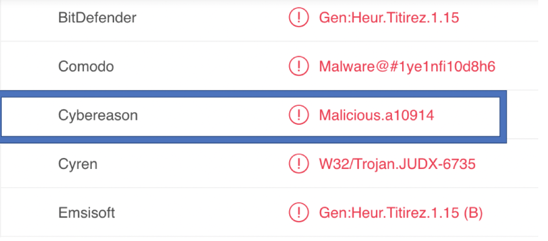
Screenshot from VirusTotal, Cybereason NGAV detects Raccoon’s executable as malicious.
Cybereason platform prevents the malicious executable.
Conclusion
Though the Raccoon stealer may not be the most innovative infostealer on the market, it is still gaining significant traction in the underground community. Based on testimonials from the underground community, The Raccoon team provides reliable customer service to give cybercriminals a quick-and-easy way to commit cybercrime without a huge personal investment.
This has not come without strife. The team has faced several public disputes in underground forums, and has received some criticism from competitors. Despite this, Raccoon has quickly become one of the top ten mentioned malware in the underground community, despite being launched in early 2019. Overall, sentiment around Raccoon is positive, with some calling it the best replacement available for the now defunct Azorult infostealer.
Raccoon’s popularity combined with its limited feature set yet high adoption speaks to a growing trend of the commoditization of malware, as malware authors shoot to create platforms for crime instead of committing the crimes directly. As malware authors choose to develop MaaS, they must partake in many of the same activities as a legitimate SaaS business: marketing efforts, relying on positive reviews, responsive customer support, and regularly improving features in their product. We only expect this trend to continue into 2020 and push the evolution of MaaS forward.
Endpoint protection is key to defending against techniques like these. Learn more during our webinar on Endpoint Protection Platforms.
APPENDIX
INDICATORS OF COMPROMISE
Review the Indicators of Compromise for the Raccoon Stealer here.
MITRE ATT&CK TECHNIQUES BREAKDOWN
